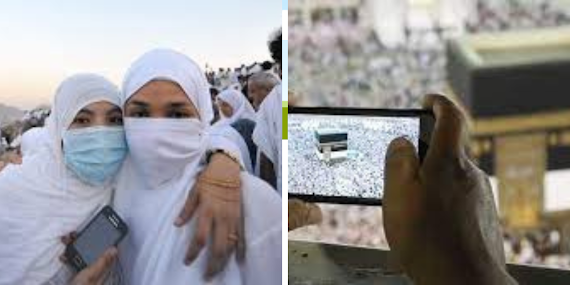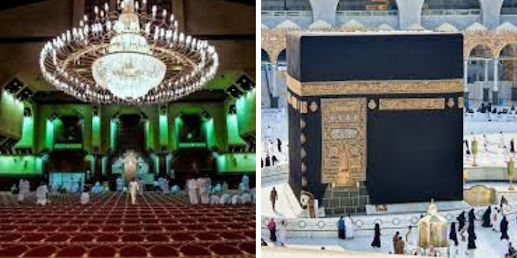How the Muslims follow the rules of Safa and Marwa during Umrah
During the Umrah, Muslims follow the ritual of Sa'i, which involves walking seven times back and forth between the hills of Safa and Marwa. This is done to commemorate the story of Hagar, the wife of Prophet Ibrahim (Abraham), who ran between these hills seven times in search of water for her infant son Ishmael.
Here's how the ritual of Sa'i is performed:
- Ihram: Before starting Sa'i, Muslims should already be in the state of Ihram, which is a sacred state of purity that requires a certain dress code and behaviour.
- Starting point: The Sa'i ritual starts at Safa, which is one of the two hills located inside the Masjid al-Haram in Makkah.
- Intention: Before starting the Sa'i, Muslims should make the intention to perform it for the sake of Allah.
- Recitation: Muslims start walking towards Marwa while reciting supplications and verses from the Quran.
- Running: When reaching the green light located on the floor, men are required to run a little bit between the two green lights. This is called "Ramal."
- Walking: After finishing the "Ramal," Muslims should continue walking at a normal pace until they reach Marwa.
- Second round: When they reach Marwa, they should turn around and head back towards Safa, walking at a normal pace.
- Seven rounds: Muslims should continue walking back and forth between Safa and Marwa seven times in total.
- Supplications: During the Sa'i, Muslims may make any supplications they wish. It is recommended to recite the supplication "Rabbana atina fid-dunya hasanatan wa fil 'akhirati hasanatan waqina 'adhaban-nar" (Our Lord, give us in this world [that which is] good and in the Hereafter [that which is] good and protect us from the punishment of the Fire).
- End: Once the seventh round is completed, the Sa'i ritual ends at Marwa.
After completing the Sa'i, Muslims then perform the final ritual of Umrah by shaving or trimming their hair. This marks the end of the Umrah and the end of the Ihram state.
Ritual of Sa'i is performed:
- Ihram
Before starting Sa'i, Muslims should already be in the state of Ihram, which is a sacred state of purity that requires a certain dress code and behaviour. The Ihram state involves wearing two pieces of white cloth for men and modest clothing for women, avoiding certain behaviours like cutting hair, using perfume, and engaging in sexual activity. Muslims enter into the state of Ihram before they arrive at the Masjid al-Haram in Makkah, and they remain in this state until they complete their Umrah.
- Starting point
: The Sa'i ritual starts at Safa, which is one of the two hills located inside the Masjid al-Haram in Makkah. Safa is located towards the right side of the Kaaba when facing it. Muslims start the Sa'i ritual by facing the direction of the Kaaba and making the intention to perform the Sa'i for the sake of Allah. Then they move towards Safa to begin the ritual.
- Intention
Before starting the Sa'i, Muslims should make the intention to perform it for the sake of Allah. This is an important aspect of any act of worship in Islam, as it helps to ensure that the action is performed with sincerity and devotion to God. Muslims should make the intention in their hearts and minds to perform the Sa'i as an act of worship and a means of drawing closer to Allah. The intention does not need to be spoken out loud, but it should be sincere and clear in the person's heart.
- Recitation
Muslims start walking towards Marwa while reciting supplications and verses from the Quran. There are several supplications and verses that are recommended to be recited during the Sa'i ritual, including:
- The first verse of Surah Al-Baqarah: "Alif, Lam, Meem. This is the Book about which there is no doubt, a guidance for those conscious of Allah." (Quran 2:1-2)
- The supplication of Prophet Ibrahim (Abraham): "Our Lord, I have settled some of my descendants in an uncultivated valley near Your sacred House, our Lord, that they may establish prayer. So make hearts among the people incline toward them and provide for them from the fruits that they might be grateful." (Quran 14:37)
- The supplication of Prophet Ibrahim and his son Ismail (Ishmael) when they built the Kaaba: "Our Lord, accept [this] from us. Indeed You are the Hearing, the Knowing." (Quran 2:127)
Muslims may also make any other supplications they wish during the Sa'i ritual, as it is a time for personal reflection and connection with Allah. The recitation should be done in a calm and respectful manner, reflecting the deep reverence and devotion that Muslims feel towards Allah.
- Running
: When reaching the green light located on the floor between Safa and Marwa, men are required to run a little bit between the two green lights. This is called "Ramal." During Ramal, men walk quickly with short, quick steps and lift their legs slightly off the ground. They should keep their shoulders relaxed and their arms down by their sides. This act of running is a symbolic representation of Hagar's search for water for her son, Ishmael. After the Ramal is completed, Muslims should continue walking at a normal pace until they reach Marwa. Women, however, do not run during the Sa'i ritual and should walk at a normal pace throughout.
- Walking
- After completing the Ramal between Safa and Marwa, Muslims continue walking towards Marwa at a normal pace. They should continue reciting supplications and verses from the Quran as they walk, and remain focused on their intention to perform this ritual as an act of worship for the sake of Allah.
When reaching Marwa, Muslims should climb up to the top of the hill and face the Kaaba. They should then make another supplication, and repeat the process of walking back to Safa. This completes one circuit of the Sa'i ritual. Muslims should perform seven circuits of Sa'i between Safa and Marwa, starting at Safa and ending at Marwa.
After completing the seventh circuit, Muslims should offer a final supplication and the Sa'i ritual is completed. Muslims then leave the Masjid al-Haram and return to their place of accommodation or perform other acts of worship in the holy city of Makkah.
- Second round
- After completing the second round of Sa'i, Muslims should offer a final supplication and the Sa'i ritual is completed. They can then proceed with the next stage of the Umrah, which may involve cutting their hair and removing the Ihram, depending on the specific circumstances and timing of their Umrah.
- Seven rounds
Actually, the total number of rounds (or circuits) of Sa'i during Umrah is seven, not two. After completing the first round, Muslims should continue with the remaining five rounds, following the same process of walking between Safa and Marwa and reciting supplications and verses from the
Quran.
The Sa'i ritual is an integral part of the Umrah, and its seven circuits symbolize the search for water by Hagar for her son Ishmael in the barren desert. The ritual represents the dedication and perseverance required to seek Allah's mercy and blessings, as well as the importance of having faith in Allah's guidance and provision.
After completing the seven circuits of Sa'i, Muslims should offer a final supplication and the Sa'i ritual is completed. They can then proceed with the next stage of the Umrah, which may involve cutting their hair and removing the Ihram, depending on the specific circumstances and timing of their Umrah.
- Supplications
There are several supplications and verses from the Quran that are recommended to be recited during the Sa'i ritual of Umrah. Some of these include:
- The first verse of Surah Al-Baqarah: "Alif, Lam, Meem. This is the Book about which there is no doubt, a guidance for those conscious of Allah." (Quran 2:1-2)
- The supplication of Prophet Ibrahim (Abraham): "Our Lord, I have settled some of my descendants in an uncultivated valley near Your sacred House, our Lord, that they may establish prayer. So make hearts among the people incline toward them and provide for them from the fruits that they might be grateful." (Quran 14:37)
- The supplication of Prophet Ibrahim and his son Ismail (Ishmael) when they built the Kaaba: "Our Lord, accept [this] from us. Indeed You are the Hearing, the Knowing." (Quran 2:127)
- The supplication of Prophet Muhammad (peace be upon him): "O Allah, forgive me, have mercy on me, guide me, provide for me, and protect me from the evil of myself and from the evil of the Shaytan (Satan)."
- The supplication of seeking Allah's forgiveness: "Astaghfirullah" (I seek Allah's forgiveness)
Muslims may also make any other supplications they wish during the Sa'i ritual, as it is a time for personal reflection and connection with Allah. The recitation should be done in a calm and respectful manner, reflecting the deep reverence and devotion that Muslims feel towards Allah.




Comments
Post a Comment